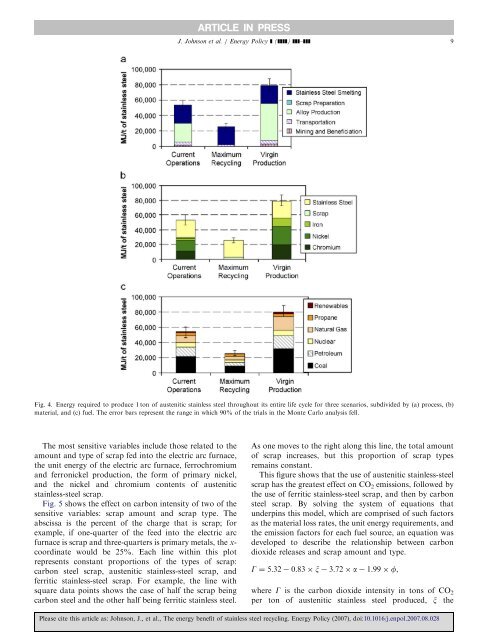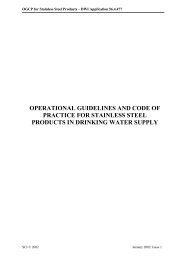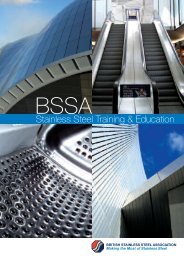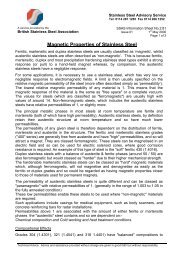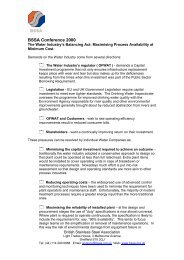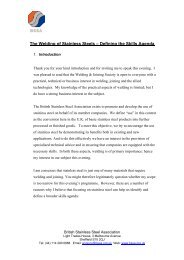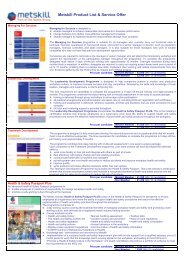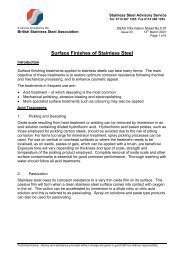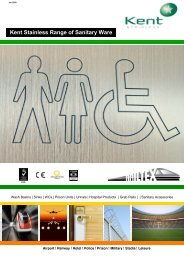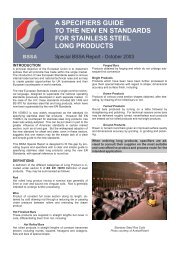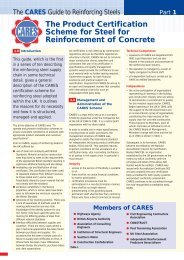The energy benefit of stainless steel recycling - British Stainless ...
The energy benefit of stainless steel recycling - British Stainless ...
The energy benefit of stainless steel recycling - British Stainless ...
You also want an ePaper? Increase the reach of your titles
YUMPU automatically turns print PDFs into web optimized ePapers that Google loves.
ARTICLE IN PRESS<br />
J. Johnson et al. / Energy Policy ] (]]]]) ]]]–]]] 9<br />
Fig. 4. Energy required to produce 1 ton <strong>of</strong> austenitic <strong>stainless</strong> <strong>steel</strong> throughout its entire life cycle for three scenarios, subdivided by (a) process, (b)<br />
material, and (c) fuel. <strong>The</strong> error bars represent the range in which 90% <strong>of</strong> the trials in the Monte Carlo analysis fell.<br />
<strong>The</strong> most sensitive variables include those related to the<br />
amount and type <strong>of</strong> scrap fed into the electric arc furnace,<br />
the unit <strong>energy</strong> <strong>of</strong> the electric arc furnace, ferrochromium<br />
and ferronickel production, the form <strong>of</strong> primary nickel,<br />
and the nickel and chromium contents <strong>of</strong> austenitic<br />
<strong>stainless</strong>-<strong>steel</strong> scrap.<br />
Fig. 5 shows the effect on carbon intensity <strong>of</strong> two <strong>of</strong> the<br />
sensitive variables: scrap amount and scrap type. <strong>The</strong><br />
abscissa is the percent <strong>of</strong> the charge that is scrap; for<br />
example, if one-quarter <strong>of</strong> the feed into the electric arc<br />
furnace is scrap and three-quarters is primary metals, the x-<br />
coordinate would be 25%. Each line within this plot<br />
represents constant proportions <strong>of</strong> the types <strong>of</strong> scrap:<br />
carbon <strong>steel</strong> scrap, austenitic <strong>stainless</strong>-<strong>steel</strong> scrap, and<br />
ferritic <strong>stainless</strong>-<strong>steel</strong> scrap. For example, the line with<br />
square data points shows the case <strong>of</strong> half the scrap being<br />
carbon <strong>steel</strong> and the other half being ferritic <strong>stainless</strong> <strong>steel</strong>.<br />
As one moves to the right along this line, the total amount<br />
<strong>of</strong> scrap increases, but this proportion <strong>of</strong> scrap types<br />
remains constant.<br />
This figure shows that the use <strong>of</strong> austenitic <strong>stainless</strong>-<strong>steel</strong><br />
scrap has the greatest effect on CO 2 emissions, followed by<br />
the use <strong>of</strong> ferritic <strong>stainless</strong>-<strong>steel</strong> scrap, and then by carbon<br />
<strong>steel</strong> scrap. By solving the system <strong>of</strong> equations that<br />
underpins this model, which are comprised <strong>of</strong> such factors<br />
as the material loss rates, the unit <strong>energy</strong> requirements, and<br />
the emission factors for each fuel source, an equation was<br />
developed to describe the relationship between carbon<br />
dioxide releases and scrap amount and type.<br />
G ¼ 5:32 0:83 x 3:72 a 1:99 f,<br />
where G is the carbon dioxide intensity in tons <strong>of</strong> CO 2<br />
per ton <strong>of</strong> austenitic <strong>stainless</strong> <strong>steel</strong> produced, x the<br />
Please cite this article as: Johnson, J., et al., <strong>The</strong> <strong>energy</strong> <strong>benefit</strong> <strong>of</strong> <strong>stainless</strong> <strong>steel</strong> <strong>recycling</strong>. Energy Policy (2007), doi:10.1016/j.enpol.2007.08.028


